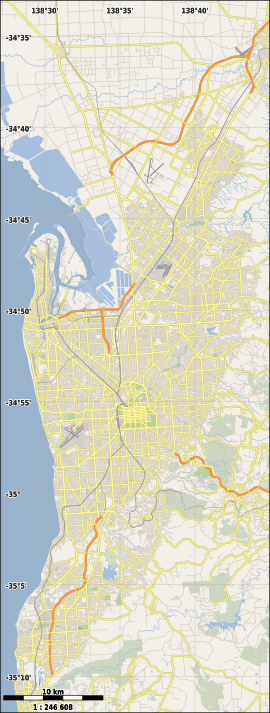Bolivar, South Australia facts for kids
Quick facts for kids BolivarAdelaide, South Australia |
|||||||||||||||
|---|---|---|---|---|---|---|---|---|---|---|---|---|---|---|---|
| Established | 1956 | ||||||||||||||
| Postcode(s) | 5110 | ||||||||||||||
| Location | 17 km (11 mi) N of Adelaide city centre | ||||||||||||||
| LGA(s) | City of Salisbury | ||||||||||||||
| State electorate(s) | Port Adelaide (2011) | ||||||||||||||
| Federal Division(s) | Spence | ||||||||||||||
|
|||||||||||||||
Bolivar is a suburb located in the outer northern part of Adelaide, South Australia. It is part of the City of Salisbury area.
Contents
History of Bolivar
The Ship Bolivar
The suburb of Bolivar is named after an old hotel called the General Bolivar Hotel. This hotel was built by Walter Walpole, a settler who arrived in South Australia in 1850. He came on a sailing ship also named Bolivar.
The ship Bolivar was a large sailing vessel built in 1826. It was 108 feet long and weighed 386 tons. One important trip for the Bolivar was in 1849-1850. It sailed from London and Plymouth in England all the way to Port Adelaide. This journey took almost four months. The ship arrived in Port Adelaide on January 28, 1850.
The ship helped bring people and goods from the United Kingdom to Australia. It was an important part of sea travel in the mid-1800s.
Who was Simon Bolivar?
The ship, and later the hotel, might have been named after Simón Bolívar. He was a famous Venezuelan soldier. Simon Bolivar led revolutions to free several South American countries from Spanish rule. He is often called "the Liberator" because of his efforts.
Early Days in Bolivar
The suburb of Bolivar was officially created in 1956. Before that, it was mostly a rural area. A post office called the Bolivar Post Office opened there in 1905. However, it closed down in 1930.
Australia's First Flights
Bolivar is famous for being the place where the first flights in Australia happened. On March 13, 1910, a pilot named Mr. Wittber was testing a plane. It looked like the Bleriot monoplane, a type of aircraft. During a test, a gust of wind lifted the plane into the air. This unexpected short flight is known as the "Wittber hop."
Just four days later, on March 17, 1910, Frederic Custance made Australia's first official monoplane flight. This historic event also took place in a paddock in Bolivar. These flights were a huge step forward for aviation in Australia.
To remember this important event, the City of Salisbury placed a special plaque and mosaic. It is located on the corner of Victoria Drive and Port Wakefield Road. This memorial celebrates the Wittber hop and Australia's first pioneering flights.
Geography of Bolivar
Bolivar is located next to the Barker Inlet. The Little Para River forms its southern border. To the east, Bolivar is bordered by Port Wakefield Road.
People of Bolivar (Demographics)
In 2006, a survey counted 119 people living in Bolivar. More than half of these residents (63.9%) were male. About 36.1% were female.
Most people living in Bolivar (69.7%) were born in Australia. Another 13.4% of residents were born in England.
The people in Bolivar tend to be older than the average Australian. In 2006, about 94.1% of residents were over 25 years old. This is higher than the Australian average of 66.5%.
What to Find in Bolivar
Bolivar Waste Water Treatment Plant
Bolivar is best known for its large Waste Water Treatment Plant. This is the biggest sewage treatment plant in South Australia. It treats about 60% of all the raw sewage from metropolitan Adelaide.
The plant does more than just treat water. It also produces recycled water. This water is then given to farmers on the Adelaide Plains to help water their crops. The plant also collects methane gas. This gas is used to create electricity, helping to power the facility. In fact, the plant generates about 85% of the electricity it needs each year.
The Bolivar plant processes a huge amount of water, about 135 million litres every day. It also produces a material called biosolids, which has been used by farmers since the 1960s.
Parks and Green Spaces
Along the southern edge of Bolivar, you'll find the Little Para River. This area has lots of green spaces and a shared path. It's a great place for walks or bike rides.
Getting Around Bolivar (Transportation)
Rail Travel
In the past, the Adelaide-Port Augusta railway line had a station named Bolivar. This station was located a few kilometres from the current suburb. Today, there is still a railway crossing loop in the area.
Roads
Bolivar is well-connected by major roads. Port Wakefield Road, which is part of Australia's National Highway, runs through the area. The North–South Motorway, a big road project in Adelaide, also serves Bolivar.
Air Travel
As mentioned in the history section, Bolivar played a key role in Australia's early aviation. The first monoplane flight in Australia happened here on March 17, 1910. This was when Frederic Custance successfully flew his aircraft in a local paddock.


